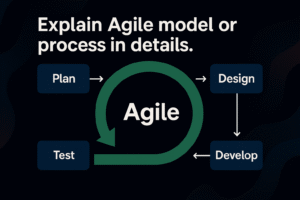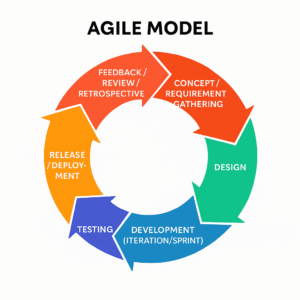Agile Model

Definition of Agile Model:
- The Agile Model is a modern software development approach that focuses on flexibility, speed, and continuous improvement.
- It uses short development cycles called “iterations” or “sprints” to deliver parts of the software quickly.
- Agile encourages constant collaboration between developers, testers, and customers.
- The goal is to create working software fast, get user feedback, and improve continuously.
- It is based on the Agile Manifesto, which values individuals, collaboration, working software, and responding to change.
Objectives of Agile Model:
- To develop high-quality software quickly and efficiently.
- To encourage close communication between developers and users.
- To allow flexible changes in requirements, even late in development.
- To deliver working software frequently.
- To continuously improve the product and the team through feedback.
- To create user satisfaction through early and continuous delivery.
Features of Agile Model:
- Iterative and Incremental:
Software is developed in small parts and improved in cycles. - Customer Collaboration:
Customers are closely involved in the development and decision-making. - Flexible and Adaptive:
Easily accommodates changes in requirements at any time. - Time-Boxed Sprints:
Work is divided into short periods (usually 1–4 weeks), called sprints. - Continuous Feedback:
Feedback is collected in every sprint to guide improvements. - Working Software Delivery:
A working part of the product is delivered in each sprint. - Self-Organizing Teams:
Teams manage themselves and decide how to complete tasks.
Phases of Agile Model:
Agile doesn’t follow strict phases like Waterfall, but common Agile development involves these steps:
1. Concept / Requirement Gathering:
- Understand the business need or problem.
- Write user stories (simple descriptions of features).
2. Planning:
- Define what features will be included in the upcoming sprint.
- Break down user stories into tasks.
3. Design:
- Simple and just-enough design is created.
- Focus is on planning for the sprint, not the whole system.
4. Development (Iteration/Sprint):
- Code the selected user stories.
- Use tools like Scrum, Kanban, or Extreme Programming (XP).
5. Testing:
- Testing is continuous and often automated.
- Bugs are fixed during the same sprint.
6. Release / Deployment:
- A working product increment is delivered.
- Can be released to users or kept for internal testing.
7. Feedback / Review / Retrospective:
- Team reviews what went well and what can be improved.
- Client/user gives feedback to improve the next sprint.
Advantages of Agile Model:
- Allows fast and early delivery of working software.
- Encourages customer satisfaction through constant involvement.
- Can handle changing requirements even late in development.
- Helps identify issues early and fix them quickly.
- Promotes transparency and team communication.
- Builds a high-quality product with continuous testing and feedback.
- Improves productivity by focusing on small deliverables.
Disadvantages of Agile Model:
- Requires frequent user involvement, which may not always be possible.
- Not ideal for small or inexperienced teams – needs skilled people.
- Can be hard to predict cost and time since work is flexible.
- Less documentation compared to traditional models.
- Without clear goals, the project can go off-track.
- Might not work well for large, fixed-scope projects.
Best Cases to Use Agile Model:
- When requirements are likely to change during development.
- For projects needing quick and regular delivery.
- When the customer wants frequent involvement.
- Ideal for web and mobile apps development.
- Best for startups or innovative projects where speed and flexibility are key.
- Works well when the team is skilled and experienced in Agile practices.

Agile Model – Hinglish
Definition of Agile Model (परिभाषा):
Agile Model ek modern software development तरीका है jo flexibility (लचीलापन), speed (तेज़ी) और continuous improvement (लगातार सुधार) पर focus करता है।
Ye model छोटे-छोटे development cycles यानी “iterations” या “sprints” में काम करता है।
Ismein developers, testers aur customers ke बीच constant collaboration (लगातार सहयोग) होता है।
Objective hota hai जल्दी working software देना, feedback lena aur use बेहतर बनाना।
Ye model Agile Manifesto पर based hai, jo individuals, collaboration, working software aur change ko accept karna value karta hai.
Objectives of Agile Model (उद्देश्य):
जल्दी और high-quality software develop karna।
Developers aur users ke बीच अच्छा communication banaye रखना।
Project के दौरान भी requirements बदल सकें, aisa environment देना।
बार-बार working software deliver करना।
हर sprint ke baad product aur team को better बनाना।
User satisfaction सुनिश्चित करना, jaldi aur लगातार delivery ke ज़रिए।
Features of Agile Model (विशेषताएँ):
Iterative और Incremental:
Software ko छोटे हिस्सों में develop किया जाता है aur हर cycle mein improve किया जाता है।
Customer Collaboration:
Customer development process mein लगातार शामिल रहता है।
Flexible और Adaptive:
Requirement में बदलाव कभी भी accept किए जा सकते हैं।
Time-Boxed Sprints:
काम छोटे समय (1–4 हफ्तों) के अंदर complete किया जाता है – इसे sprint कहते हैं।
Continuous Feedback:
हर sprint के बाद feedback लिया जाता है ताकि अगली बार बेहतर किया जा सके।
Working Software Delivery:
हर sprint के end पर एक काम करने वाला हिस्सा deliver किया जाता है।
Self-Organizing Teams:
Team members खुद decide करते हैं कि कौन सा काम कैसे होगा।
Phases of Agile Model (फेज़ / चरण):
1. Concept / Requirement Gathering (आवश्यकता समझना):
Project ka मकसद समझना।
User stories likhna (simple तरीके से feature को explain करना)।
2. Planning (योजना बनाना):
Decide करना कि इस sprint में क्या-क्या features होंगे।
User stories को छोटे-छोटे tasks में divide करना।
3. Design (डिज़ाइन बनाना):
Minimal aur जरूरी design तैयार करना।
पूरे सिस्टम की बजाय current sprint पर focus करना।
4. Development (Iteration/Sprint):
Code लिखना user stories के हिसाब से।
Scrum, Kanban, या XP जैसी Agile techniques use करना।
5. Testing (परीक्षण):
हर sprint में continuous aur automated testing करना।
Bug आए तो उसी sprint में fix करना।
6. Release / Deployment (रिलीज़ करना):
जो काम किया गया है उसे release करना (users को देना या अंदर ही रखना)।
7. Feedback / Review / Retrospective (समीक्षा और फीडबैक):
Team चर्चा करती है कि क्या अच्छा हुआ aur क्या बेहतर हो सकता है।
Client feedback deta hai ताकि next sprint aur अच्छा हो।
Advantages of Agile Model (फायदे):
जल्दी aur बार-बार working software मिल जाता है।
Customer satisfaction बढ़ती है क्योंकि वो हर step में जुड़ा होता है।
Last moment पर bhi requirement change handle कर सकते हैं।
Bugs और errors जल्दी पकड़ में आते हैं aur fix भी जल्दी होते हैं।
Team के बीच transparency और communication बेहतर होता है।
Product की quality high रहती है, testing बार-बार होती है।
छोटी deliveries पर focus होने से productivity भी बढ़ती है।
Disadvantages of Agile Model (नुकसान):
Har time customer ka involvement ज़रूरी होता है, जो हमेशा possible नहीं होता।
Naye या inexperienced teams के लिए मुश्किल हो सकता है।
Cost aur time ka prediction mushkil hota hai।
Traditional models की तुलना में कम documentation होती है।
Agar clear goal ना हो तो project off-track जा सकता है।
Fixed scope aur बड़े projects के लिए यह perfect नहीं होता।
Best Cases to Use Agile Model (Agile Model कब Use करें):
जब requirement बदलती रहती है।
जब project को जल्दी-जल्दी deliver करना हो।
जब customer बार-बार feedback देना चाहता हो।
Web apps, mobile apps aur fast changing tech projects के लिए best है।
Startups aur naye ideas के लिए, जहाँ speed aur flexibility ज़रूरी हो।
जब team experienced हो aur Agile methods अच्छे से जानती हो।